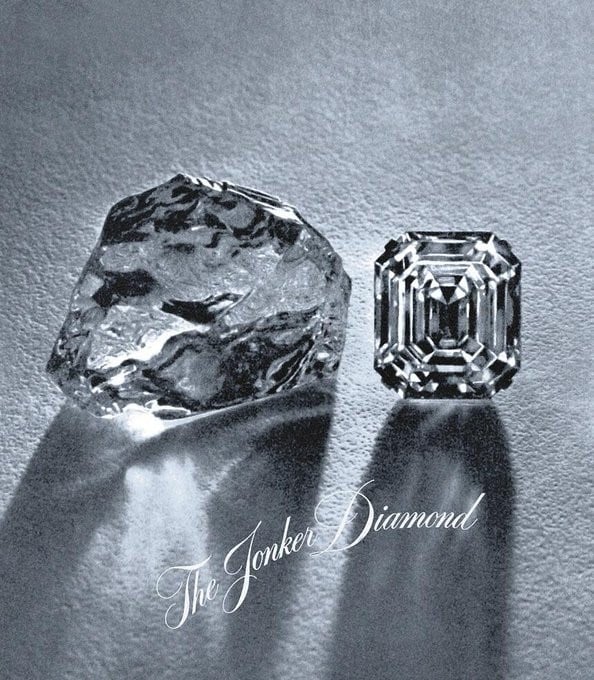World’s Biggest & Rarest Colored Gems Are on Display in L.A.
3 Minute Read
The Natural History Museum of Los Angeles County and Robert Procop Exceptional Jewels are proud to present a once-in-a-lifetime display of over two dozen natural colored gems that each weigh over 100 carats. These large and rare gems were destined for fame and royalty when they were unearthed from our planet's crust.
At the center of the exhibit is the Jonker I Diamond, the largest stone cut from the famous Jonker Diamond, which was the fourth largest diamond in the world when it was found in 1934.
Weighing a whopping 726 carats and with an extraordinary flawless D-coloring, it's said that diamond digger Johannes Jacobus Jonker initially thought the stone was glass. Later purchased by the American "King of Diamonds" Harry Winston, he cut the massive diamond into 13 smaller diamonds. The Jonker 1 weighs the most at an eye-popping 125 carats.
Since then the famous diamond has been owned by royalty and even Hollywood stars, but it hasn't been in the public eye for nearly half a century. So, it's only fitting now that the stone is on display amongst its gigantic, colorful and rare peers.
"The collection presented within '100 Carats' is unrivaled in both importance and rarity within the gem world," said Dr. Lori Bettison-Varga, president and director of NHMLAC. "Gems of such magnificent size and quality have never been displayed before in this quantity in one exhibition. This unique exhibition captures the brilliance of our mineral sciences collection and offers a breathtaking experience for our visitors this winter and beyond."
Alongside the Jonker 1, visitors will have the chance to see phenomenal stones like the"Crown of Colombia," a 241-carat emerald that is renowned as the most perfect emerald cut gem ever. The cut, which gets its moniker from this very stone, features diagonal corners that help seal in the color and protect the stone from chipping. To anyone who adores emeralds or this cut, seeing this example on display is truly an exciting experience.
Also on display is the showstopping natural beauty of the 108-carat aquamarine known as "The Blue Star." This stone is special not only because of its size, but because it is a rare example of an aquamarine stone that hasn't undergone any heat treatments to intensify its colors.
Visitors can also see the dazzling "The Pink Princess," a rare sapphire that isn't blue, but pink. In fact, it is so pink that it almost borders on being a ruby. But, that bubblegum pink color is what distinguishes it from the ruby family and makes it a "fancy sapphire." Weighing 110-carats, visitors will get the chance to truly absorb just how remarkable this stone and coloring is.
100 Carats: Icons of the Gem World also displays gemstones you've likely never seen before, like the 153-carat bi-colored topaz known as "The Ukrainian Flag" for its yellow and blue coloring. Not only is a stone like this fascinating to gawk at, but curators say stones like this provide an unparalleled glimpse into geological processes and circumstances that happened millions of years ago to form them in the first place. "The Ukrainian Flag," for example, likely formed due to a change in chemicals around the crystal, suggesting a significant shift in the atmosphere as the massive gem reached its enormous size.
"Their existence is evidence of massive mountain-building events, violent volcanic eruptions, and the unforgiving pressures and temperatures of the Earth's interior," the NHMLAC explained. These events led to the formation of other rare gems on display like the exceedingly rare, 111-carat green tourmaline known as the Imperial Tourmaline. Formed with small amounts of vanadium and chromium in the crystal, it is an incredible example of a tourmaline this size with such great color and clarity, as the stone is known for having weaker color and defects the larger it gets.
Those wishing to see these examples and the full 17-gemstone "100 Carats: Icons of the Gem World" exhibit can do so between now and April 21, 2024.
Cate Misczuk
Cate Misczuk is a jewelry and watch writer who covers everything from the latest jewelry trends and the heritage of watchmaking to 24k gold, gems, sustainability, unisex timepieces and more. Get in touch at catemisczuk.com.
Related Articles
U.S. Sanctions Russian Diamonds Over Ukraine Invasion
2023 Holiday Gemstone Jewelry Trends
Almost Three Years Later, Covid-19 Continues to Plague Gemstone Mining in Brazil and Madagascar
Turquoise Hill: a Profile of the Cerrillos Turquoise Mines
Latest Articles
Morganite Buying Guide
How Do Amethysts Form?
Rhodizite Value, Price, and Jewelry Information
Pearl Treatments and Enhancements
Never Stop Learning
When you join the IGS community, you get trusted diamond & gemstone information when you need it.
Get Gemology Insights
Get started with the International Gem Society’s free guide to gemstone identification. Join our weekly newsletter & get a free copy of the Gem ID Checklist!
